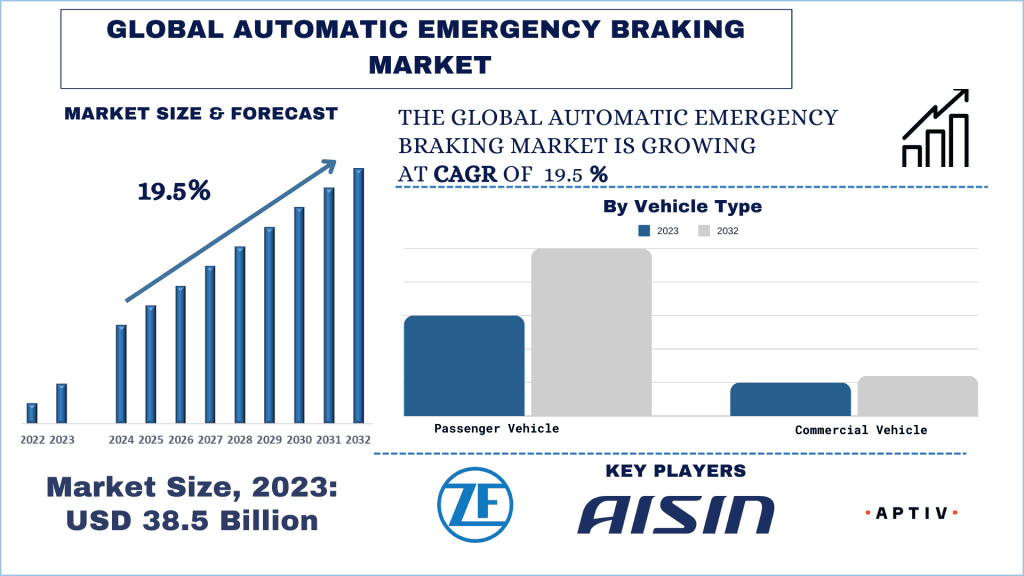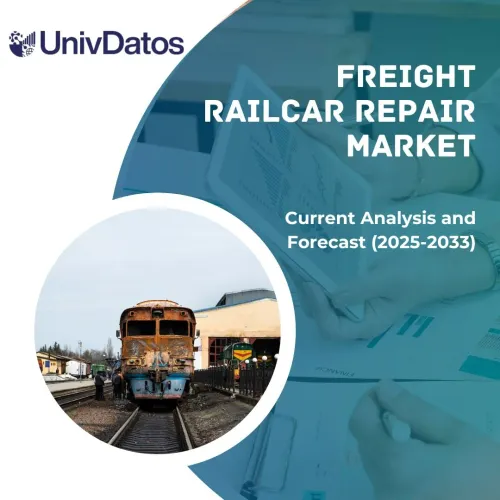- Accueil
- À propos de nous
- Industrie
- Services
- Lecture
- Contactez-nous
Marché du freinage d'urgence automatique : analyse actuelle et prévisions (2024-2032)
Accent sur le système (AEBS à basse vitesse, AEBS à haute vitesse), le type de véhicule (véhicule de tourisme et véhicule utilitaire), la technologie (assistance au freinage dynamique et freinage d'urgence anticollision) et la région/pays.
Taille et prévisions du marché du freinage d'urgence automatique
Le marché du freinage d'urgence automatique était évalué à 38,5 milliards USD en 2023 et devrait croître à un TCAC robuste d'environ 19,5 % au cours de la période de prévision (2024-2032).
Analyse du marché du freinage d'urgence automatique
La sensibilisation croissante des consommateurs, les activités de R&D importantes des acteurs de l'industrie et les évaluations mises à jour des agences de sécurité ont propulsé l'expansion du marché du freinage d'urgence automatique. Les systèmes de freinage d'urgence automatisés de base sont déjà standard et optionnels sur certains modèles grand public des grands constructeurs automobiles. Les progrès de la technologie de détection d'images et la baisse des prix des caméras favorisent le déploiement mondial de l'automobilecaméras. Parallèlement, les coûts élevés et imprévisibles de la production d'automobiles équipées de systèmes AEB et d'avertissement de collision (CWS) entraveront l'expansion du marché.
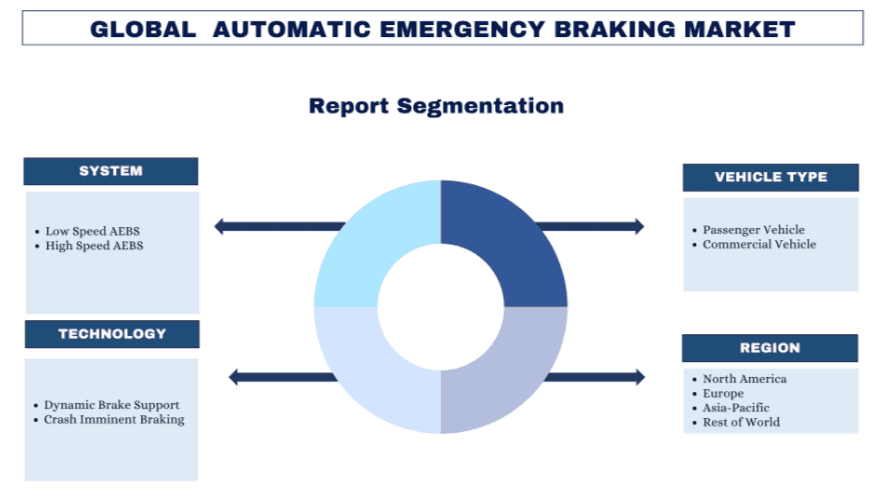
Tendances du marché du freinage d'urgence automatique
Cette section traite des principales tendances du marché qui influencent les différents segments du marché du freinage d'urgence automatique, telles qu'identifiées par notre équipe d'experts en recherche.
AEB à basse vitesse Segment transformant l'industrie
En 2023, le marché était dominé par le secteur de l'AEB à basse vitesse. En raison de la capacité des systèmes de freinage d'urgence avancés à prévenir efficacement les accidents et à atténuer la gravité des accidents à basse vitesse, la demande pour ces systèmes a augmenté. Les dispositifs AEB fonctionnant à basse vitesse sont utiles lors du stationnement et de la navigation dans des endroits confinés. Ces systèmes peuvent reconnaître les obstacles lors des manœuvres à basse vitesse, tels que les murs, les autres voitures ou les piétons, et peuvent automatiquement actionner les freins pour éviter les collisions. L'objectif d'accroître la sécurité et de réduire la possibilité d'accidents lors du stationnement et des manœuvres a conduit à la demande de systèmes de freinage à basse vitesse au cours de la période de prévision.
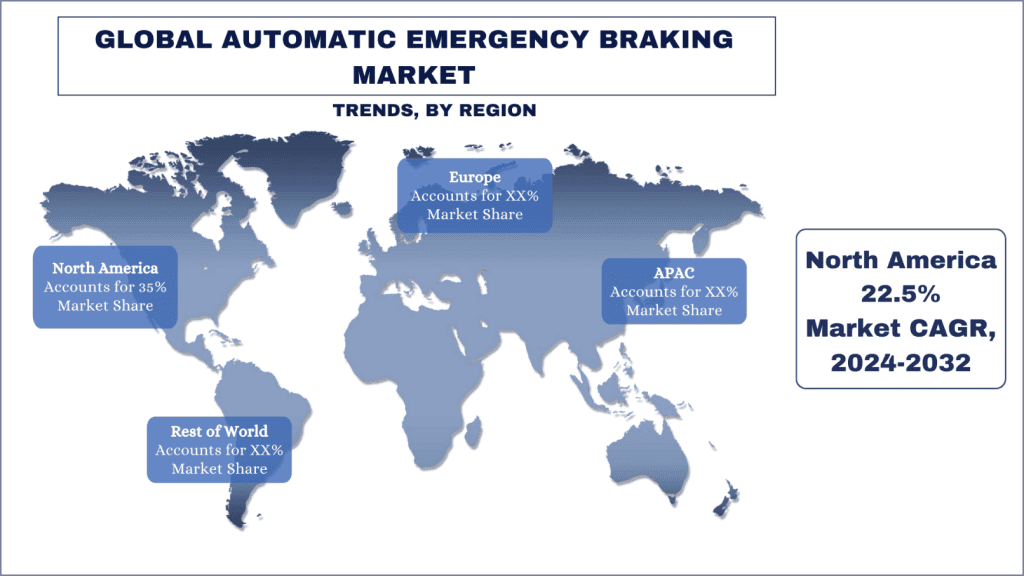
L'Amérique du Nord devrait croître avec un TCAC significatif au cours de la période de prévision.
En 2023, l'Amérique du Nord détenait une part de marché dominante sur le marché mondial du freinage d'urgence automatique. Une demande importante a récemment été constatée sur le marché nord-américain, et une croissance est anticipée. En Amérique du Nord, la préoccupation croissante pour la sécurité routière met l'accent sur la réduction de la fréquence et de la gravité des accidents. Les systèmes de freinage modernes sont des composants de sécurité essentiels qui peuvent atténuer ou éviter les collisions. Les systèmes de freinage d'urgence automatisés sont de plus en plus populaires en raison de la sensibilisation et de la demande croissantes en matière de sécurité routière. De plus, en Amérique du Nord, la connaissance des consommateurs des avantages des systèmes de freinage d'urgence a augmenté. Les acheteurs soucieux de leur sécurité apprécient beaucoup les caractéristiques de sécurité modernes, comme les systèmes de freinage d'urgence, car elles offrent unesécurité.
Aperçu de l'industrie du freinage d'urgence automatique
Le marché du freinage d'urgence automatique est concurrentiel et fragmenté, avec plusieurs acteurs du marché mondiaux et internationaux. Les principaux acteurs adoptent différentes stratégies de croissance pour améliorer leur présence sur le marché, telles que les partenariats, les accords, les collaborations, les lancements de nouveaux produits, les expansions géographiques et les fusions et acquisitions. Parmi les principaux acteurs opérant sur le marché, on trouve Continental AG, Aptiv, AISIN CORPORATION, Phinia Inc., DENSO CORPORATION, Hitachi, Ltd., HYUNDAI MOBIS, Magna International Inc., Robert Bosch GmbH et ZF Friedrichshafen AG.
Actualités du marché du freinage d'urgence automatique
- En janvier 2024, Mobileye et ZF ont annoncé une collaboration pour développer un nouveau système AEB qui combine la technologie de détection visuelle de Mobileye avec les systèmes de freinage avancés de ZF.
- En septembre 2023, Toyota a annoncé le lancement du système mis à jour Toyota Safety Sense 2.5+ (TSS 2.5+), qui comprend des capacités AEB améliorées.
Couverture du rapport sur le marché du freinage d'urgence automatique
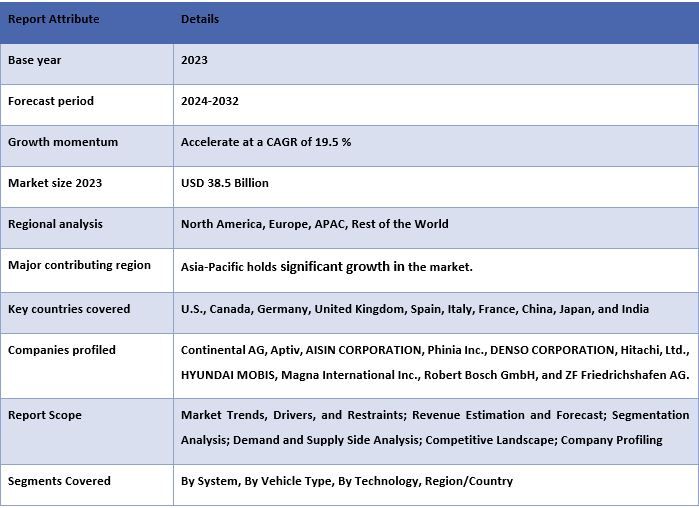
Raisons d'acheter ce rapport :
- L'étude comprend une analyse de dimensionnement et de prévision du marché validée par des experts clés du secteur authentifiés.
- Le rapport examine brièvement la performance globale de l'industrie en un coup d'œil.
- Le rapport couvre une analyse approfondie des principaux acteurs de l'industrie, en mettant l'accent sur les finances commerciales clés, les portefeuilles de produits, les stratégies d'expansion et les développements récents.
- Examen détaillé des moteurs, des contraintes, des principales tendances et des opportunités prévalant dans l'industrie.
- L'étude couvre de manière exhaustive le marché dans différents segments.
- Analyse approfondie du marché au niveau régional.
Options de personnalisation :
Le marché mondial du freinage d'urgence automatique peut être personnalisé en fonction des besoins ou de tout autre segment de marché. En outre, UMI comprend que vous pouvez avoir vos propres besoins commerciaux, n'hésitez donc pas à nous contacter pour obtenir un rapport qui correspond parfaitement à vos exigences.
Table des matières
Méthodologie de recherche pour l'analyse du marché du freinage d'urgence automatique (2024-2032)
L'analyse du marché historique, l'estimation du marché actuel et la prévision du marché futur du marché mondial du freinage d'urgence automatique ont été les trois étapes majeures entreprises pour créer et analyser l'adoption du freinage d'urgence automatique dans les principales régions du monde. Des recherches secondaires exhaustives ont été menées pour collecter les chiffres historiques du marché et estimer la taille actuelle du marché. Deuxièmement, pour valider ces informations, de nombreuses conclusions et hypothèses ont été prises en considération. De plus, des entretiens primaires exhaustifs ont également été menés, avec des experts de l'industrie tout au long de la chaîne de valeur du marché mondial du freinage d'urgence automatique. Après l'hypothèse et la validation des chiffres du marché par le biais d'entretiens primaires, nous avons employé une approche descendante/ascendante pour prévoir la taille complète du marché. Par la suite, des méthodes de ventilation du marché et de triangulation des données ont été adoptées pour estimer et analyser la taille du marché des segments et des sous-segments de l'industrie. La méthodologie détaillée est expliquée ci-dessous :
Analyse de la taille du marché historique
Étape 1 : Étude approfondie des sources secondaires :
Une étude secondaire détaillée a été menée pour obtenir la taille historique du marché du marché du freinage d'urgence automatique par le biais de sources internes de l'entreprise telles que les rapports annuels et les états financiers, les présentations de performance, les communiqués de presse, etc., et de sources externes, notamment des revues, des actualités et des articles, des publications gouvernementales, des publications de concurrents, des rapports sectoriels, des bases de données tierces,et d'autres publications crédibles.
Étape 2 : Segmentation du marché :
Après avoir obtenu la taille historique du marché du marché du freinage d'urgence automatique, nous avons mené une analyse secondaire détaillée pour recueillir des informations historiques sur le marché et des parts pour différents segments et sous-segments des principales régions. Les principaux segments sont inclus dans le rapport en tant que système, type de véhicule et technologie. Des analyses au niveau des pays ont en outre été menées pour évaluer l'adoption globale des modèles de test dans cette région.
Étape 3 : Analyse factorielle :
Après avoir acquis la taille historique du marché des différents segments et sous-segments, nous avons mené une analyse factorielle détaillée pour estimer la taille actuelle du marché du marché du freinage d'urgence automatique. En outre, nous avons mené une analyse factorielle en utilisant des variables dépendantes et indépendantes telles que le système, le type de véhicule et la technologie du marché du freinage d'urgence automatique. Une analyse approfondie a été menée pour les scénarios de l'offre et de la demande, en tenant compte des principaux partenariats, fusions et acquisitions, expansion commerciale et lancements de produits dans le secteur mondial du marché du freinage d'urgence automatique.
Estimation et prévisions de la taille actuelle du marché
Dimensionnement actuel du marché :Sur la base d'informations exploitables issues des 3 étapes ci-dessus, nous sommes parvenus à la taille actuelle du marché, aux principaux acteurs du Marché mondial du freinage d'urgence automatique et aux parts de marché des segments. Toutes les parts de pourcentage requises, les répartitions et les ventilations du marché ont été déterminées en utilisant l'approche secondaire susmentionnée et ont été vérifiées par des entretiens primaires.
Estimation et prévision :Pour l'estimation et les prévisions du marché, des pondérations ont été attribuées à différents facteurs, notamment les moteurs et les tendances, les contraintes et les opportunités disponibles pour les parties prenantes. Après avoir analysé ces facteurs, des techniques de prévision pertinentes, c'est-à-dire l'approche ascendante/descendante, ont été appliquées pour parvenir aux prévisions du marché pour 2032 pour différents segments et sous-segments sur les principaux marchés à l'échelle mondiale. La méthodologie de recherche adoptée pour estimer la taille du marché comprend :
- La taille du marché de l'industrie, en termes de revenus (USD) et le taux d'adoption du marché du freinage d'urgence automatique sur les principaux marchés nationaux.
- Toutes les parts de pourcentage, les répartitions et les ventilations des segments et sous-segments de marché
- Principaux acteurs du marché mondial du freinage d'urgence automatique en termes de produits proposés. De plus, les stratégies de croissance adoptées par ces acteurs pour concurrencer sur le marché en croissance rapide.
Validation de la taille et de la part de marché
Recherche primaire :Des entretiens approfondis ont été menés avec les principaux leaders d'opinion (KOL), y compris les cadres supérieurs (CXO/VP, responsables des ventes, responsables du marketing, responsables opérationnels, responsables régionaux, responsables pays, etc.) dans les principales régions. Les résultats de la recherche primaire ont ensuite été résumés et une analyse statistique a été effectuée pour prouver l'hypothèse énoncée. Les données de la recherche primaire ont été consolidées avec les résultats secondaires, transformant ainsi l'information en informations exploitables.
Répartition des participants principaux dans différentes régions
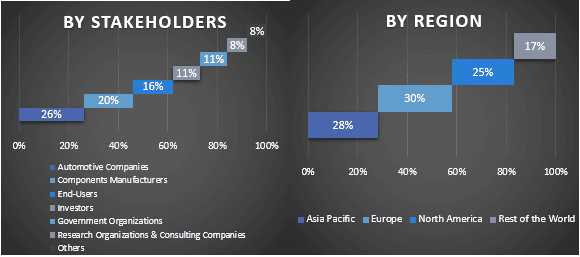
Ingénierie de marché
La technique de triangulation des données a été employée pour achever l'estimation globale du marché et parvenir à des chiffres statistiques précis pour chaque segment et sous-segment du Marché mondial du freinage d'urgence automatique. Après avoir étudié divers paramètres et tendances dans le système, le type de véhicule et la technologie du Marché mondial du freinage d'urgence automatique, les données ont été divisées en plusieurs segments et sous-segments.
L'objectif principal de l'étude de marché mondiale du freinage d'urgence automatique
Les tendances actuelles et futures du marché du marché mondial du freinage d'urgence automatique ont été identifiées dans l'étude. Les investisseurs peuvent obtenir des informations stratégiques pour fonder leur discrétion en matière d'investissement sur l'analyse qualitative et quantitative effectuée dans l'étude. Les tendances actuelles et futures du marché ont déterminé l'attractivité globale du marché au niveau régional, offrant une plateforme aux participants industriels pour exploiter le marché inexploité afin de bénéficier d'un avantage de premier arrivé. D'autres objectifs quantitatifs des études comprennent :
- Analyser la taille actuelle et prévue du marché du freinage d'urgence automatique en termes de valeur (USD) et la taille actuelle et prévue du marché des différents segments et sous-segments.
- Les segments de l'étude comprennent les domaines du système, du type de véhicule et de la technologie.
- Définir et analyser le cadre réglementaire pour le freinage d'urgence automatique
- Analyser la chaîne de valeur impliquée avec la présence de divers intermédiaires, ainsi qu'analyser les comportements des clients et des concurrents de l'industrie.
- Analyser la taille actuelle et prévue du marché du freinage d'urgence automatique pour la région majeure.
- Les principaux pays des régions étudiées dans le rapport comprennent l'Asie-Pacifique, l'Europe, l'Amérique du Nord et le reste du monde
- Profils d'entreprises du marché du freinage d'urgence automatique et les stratégies de croissance adoptées par les acteurs du marché pour se maintenir sur le marché en croissance rapide.
- Analyse approfondie du niveau régional de l'industrie.
Questions Fréquemment Posées FAQ
Q1 : Quelle est la taille actuelle et le potentiel de croissance du marché du freinage d'urgence automatique ?
Q2 : Quels sont les facteurs déterminants de la croissance du marché du freinage d'urgence automatique ?
Q3 : Quel segment détient la plus grande part de marché du freinage d'urgence automatique par type de véhicule ?
Q4 : Quelles sont les technologies et les tendances émergentes sur le marché du freinage d'urgence automatique ?
Q5 : Quelle région dominera le marché du freinage d'urgence automatique ?
Connexes Rapports
Les clients qui ont acheté cet article ont également acheté

